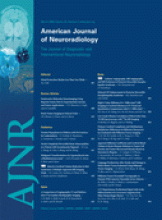Abstract
BACKGROUND AND PURPOSE: High b-value diffusion-weighted imaging (DWI) provides different features not appreciated at lower b-value and have been recently studied in several clinical issues. The purpose of this study was to assess whether DWI at b = 3000 s/mm2 is more useful in discriminating high-grade and low-grade gliomas than DWI at b = 1000 s/mm2 at 3T.
MATERIALS AND METHODS: DWIs at both b = 1000 and 3000 s/mm2 were performed at 3T in 62 patients, 49 high-grade gliomas (20 World Health Organization [WHO] grade III and 29 grade IV) and 13 low-grade gliomas (13 grade II). Visual assessments based on 5-point scaled evaluations, receiver operating characteristic (ROC) curve analysis, and quantitative assessment based on DWI signal intensity (SI) ratio (tumor SI/normal SI) and apparent diffusion coefficient (ADC) values were compared between DWIs at b = 1000 and 3000 s/mm2.
RESULTS: By visual assessment, DWI at b = 3000 s/mm2 showed more conspicuous hyperintensity in high-grade gliomas and hypointensity in low-grade gliomas than DWI at b = 1000 s/mm2. Sensitivity and specificity at b = 3000 s/mm2 were higher than at b = 1000 s/mm2 (83.7%, 84.6% vs 69.4%, 76.9%, respectively). Quantitative assessments showed that mean SI ratio of high-grade gliomas was significantly higher than that of low-grade gliomas at both b-values. The mean ADC value of high-grade gliomas was significantly lower than that of low-grade gliomas at both b-values. The difference between the SI ratios of high-grade and low-grade gliomas was significantly larger at b = 3000 s/mm2 than at b = 1000 s/mm2.
CONCLUSION: DWI at b = 3000 s/mm2 is more useful than DWI at b = 1000 s/mm2 in terms of discriminating high-grade and low-grade gliomas at 3T.
- Copyright © American Society of Neuroradiology












